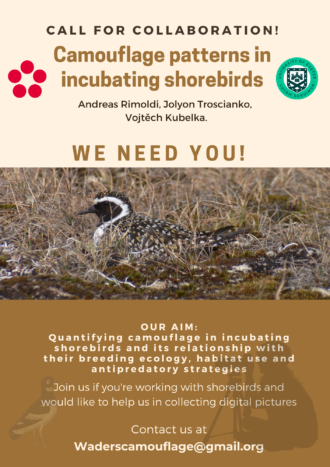Camouflage patterns in incubating shorebirds | Call for collaboration
on behalf of Andreas Rimoldi & Vojtěch Kubelka
Dear fellow shorebird researchers and enthusiasts:
We would like to ask you collaboration for gathering data for new research project, where we aim to analyse the camouflage characteristics of adult incubating shorebirds.
Background and research rationale
Nest predation is a significant cause of avian nest mortality, and in ground-nesting species evading nest detection is an important form of anti-predatory strategy. Egg camouflage has been extensively studied, proving how camouflage predicts survival, when studying shorebirds and nightjars. In the same species, escape distance is possibly related to camouflage on individual scale, of both eggs and adults. Additionally, microhabitat selection and modification on individual level increase the individual camouflage of both nests and adults. We are comparatively investigating adult camouflage in incubating shorebirds, testing the individual camouflage against environmental, life history and geographical variables (e.g. nesting habitat from a broader scale to microhabitat selection, and behavioural variables like mating system and other nest-defense and other anti-predatory behaviour, to provide a detailed insight on how shorebirds rely on and use this anti-predatory strategy.
Since it is already known that ground nesting-birds may suffer increase predation rates in changing landscapes, understanding the role of camouflage and how this influences the nest selection sites and survivability will help design future conservation strategies.
Request for data
We are interested in all shorebird species from all over the world, without the help of the IWSG shorebird community we would not be able to cover the whole diversity of those wonderful animals breeding all over the world!
We are looking for RAW pictures of incubating shorebirds, taken in a side view and centered in a representative portion of the nesting environment, with associated data regarding the observed bird. Every camera that can shoot in RAW is suitable for the project. Unfortunately, pictures recorded with nest-cameras, camera traps or digiscoping would not be suitable for this project.
If you already have some pictures with associated information, please get in touch with us and we will be happy to consider them if they meet the set-up criteria. The project is not only for shorebird researchers. If you know a photographer or birdwatcher that would be interested and able to help, please inform them about the project.
In this project, we will use the dataset gathered up to the end of the year 2023 or start of the year 2024 and we will offer co-authorship in the resulting publication(s) to the collaborators providing suitable photographs used in the analyses.
Thank you very much for sharing this opportunity and if interested please get in touch for details.
Best wishes,
Andreas Rimoldi (Rimoldi.andreas@yahoo.com, waderscamouflage@gmail.com) & Vojtěch Kubelka (kubelkav@gmail.com)

